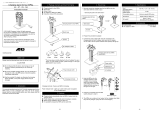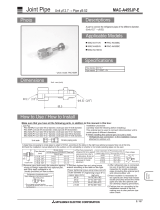
En-1
1. SAFETY PRECAUTIONS
1.1. For authorized service personnel only
WARNING
This mark indicates procedures which, if improperly per-
formed, might lead to the death or serious injury of the user.
For the room air conditioner to operate satisfactory, install it as outlined in this installa-
tion manual.
Connect the indoor unit and outdoor unit with the air conditioner piping and cords avail-
able standards parts. This installation manual describes the correct connections using
the standard accessories and the parts specifi ed in this installation manual.
Have installation work done by authorized service personnel only.
Do not use an extension cord.
Do not turn on the power until all installation work is complete.
CAUTION
This mark indicates procedures which, if improperly
performed, might possibly result in personal harm to the user,
or damage to property.
When installing pipes shorter than 3 m, sound of the outdoor unit will be transferred to
the indoor unit, which will cause large operating sound or some abnormal sound.
This installation manual describes how to install the outdoor unit only.
To install the indoor unit, refer to the installation manual included with the indoor unit.
• Be careful not to scratch the air conditioner when handling it.
• After installation, explain correct operation to the customer, using the operating manual.
• Let the customer keep this installation manual because it is used when the air condi-
tioner is serviced or moved.
• The maximum length of the piping is 25 m. The maximum height difference of the pip-
ing is 20 m, if the units are further apart than these, correct operation cannot be guar-
anteed.
2. ABOUT THE UNIT
2.1. Precautions for using R410A refrigerant
The basic installation work procedures are the same as conventional refrigerant (R22)
models.
However, pay careful attention to the following points:
Since the working pressure is 1.6 times higher than that of conventional refrigerant
(R22) models, some of the piping and installation and service tools are special. (See
the table below.)
Especially, when replacing a conventional refrigerant (R22) model with a new refrigerant
R410A model, always replace the conventional piping and flare nuts with the R410A piping
and fl are nuts.
Models that use refrigerant R410A have a different charging port thread diameter to pre-
vent erroneous charging with conventional refrigerant (R22) and for safety. Therefore,
check beforehand. [The charging port thread diameter for R410A is 1/2 inch.]
Contents
1. SAFETY PRECAUTIONS .......................................................................................... 1
2. ABOUT THE UNIT ..................................................................................................... 1
3. SELECTING THE MOUNTING POSITION ............................................................... 2
4. INSTALLATION DIAGRAM ........................................................................................ 2
5. INSTALLATION ......................................................................................................... 3
6. PUMP DOWN ............................................................................................................ 4
Be more careful that foreign matter (oil, water, etc.) does not enter the piping than with
refrigerant (R22) models. Also, when storing the piping, securely seal the opening by
pinching, taping, etc.
When charging the refrigerant, take into account the slight change in the composition of
the gas and liquid phases. And always charge from the liquid phase where refrigerant
composition is stable.
2.2. Special tools for R410A
Tool name Contents of change
Gauge manifold
Pressure is high and cannot be measured with a conven-
tional (R22) gauge. To prevent erroneous mixing of other
refrigerants, the diameter of each port has been changed.
It is recommended the gauge with seals -0.1 to 5.3 MPa
(-1 to 53 bar) for high pressure.
-0.1 to 3.8 MPa (-1 to 38 bar) for low pressure.
Charge hose
To increase pressure resistance, the hose material and base
size were changed.
Vacuum pump
A conventional vacuum pump can be used by installing a
vacuum pump adapter.
Gas leakage detector Special gas leakage detector for HFC refrigerant R410A.
Copper pipes
It is necessary to use seamless copper pipes and it is desirable that the amount of residual
oil is less than 40 mg/10 m. Do not use copper pipes having a collapsed, deformed or
discolored portion (especially on the interior surface). Otherwise, the expansion value or
capillary tube may become blocked with contaminants.
As an air conditioner using R410A incurs pressure higher than when using R22, it is neces-
sary to choose adequate materials.
Thicknesses of copper pipes used with R410A are as shown in Table1. Never use copper
pipes thinner than 0.8 mm even when it is available on the market.
Thicknesses of Annealed Copper Pipes
Nominal
diameter
Outer
diameter
Thickness
Maximum
length
Maximum height
(between indoor and out-
door)
1/4 in 6.35 mm 0.8 mm
25 m (82 ft) 20 m (66 ft)
1/2 in 12.7 mm 0.8 mm
WARNING
Do not use the existing (for R22) piping and fl are nuts.
If the existing materials are used, the pressure inside the refrigerant cycle will rise and
cause failure, injury, etc. (Use the special R410A materials.)
When installing and relocating the air conditioner, do not mix gases other than
the specifi ed refrigerant (R410A) to enter the refrigerant cycle.
If air or other gas enters the refrigerant cycle, the pressure inside the cycle will rise to
an abnormally high value and cause failure, injury, etc.
2.3. Power
• The rated voltage
230 V AC 50 Hz.
WARNING
The rated voltage of this product is 230 V AC 50 Hz.
Before turning on the power, check if the voltage is within the 220 V -10 % to 240 V
+10 % range.
Always use a special branch circuit and install a special receptacle to supply power to
the room air conditioner.
Use a circuit breaker and receptacle matched to the capacity of the air conditioner.
Do not extend the power cable.
Perform wiring work in accordance with standards so that the air conditioner can be
operated safely and positively.
Install a leakage circuit breaker in accordance with the related laws and regulations
and electric company standards.
The circuit breaker is installed in the permanent wiring. Always use a circuit that can
trip all the poles of the wiring and has an isolation distance of at least 3 mm between
the contacts of each pole.
CAUTION
The power source capacity must be the sum of the air conditioner current and the cur-
rent of other electrical appliances. When the current contracted capacity is insuffi cient,
change the contracted capacity.
When the voltage is low and the air conditioner is diffi cult to start, contact the power
company the voltage raised.
AIR CONDITIONER
OUTDOOR UNIT
INSTALLATION MANUAL
9377863119
9377863119_IM.indb 19377863119_IM.indb 1 1/20/2011 6:09:01 PM1/20/2011 6:09:01 PM





 1
1
 2
2
 3
3
 4
4
 5
5
Fujitsu AOHG09LVCA Installation guide
Fujitsu AOYG14LMCE Installation guide
Fujitsu AOHG09LMCA Installation guide
Fujitsu AOHG24LFCC Installation guide
Fujitsu AOYG07LMCE-R Installation guide
Fujitsu AOYG14LMCE-R Installation guide
Fujitsu AOTG18LACC Installation guide
Fujitsu ROG18LBCA Installation guide
Fujitsu AOHG24LALA Installation guide
Fujitsu AOGG24LFCD Installation guide
EASTMAN 45033 Operating instructions
Friedrich M18CFKIT Installation guide
Hitachi RAC-F10CF Installation guide
Acson M5WMY15LR Installation guide
 AND AX-ST-CH-M4 User manual
AND AX-ST-CH-M4 User manual
Trane ADAMO MCW 5247BA00 Installation guide
 Mitsubishi Electronics USA MAC-A455JP-E Installation guide
Mitsubishi Electronics USA MAC-A455JP-E Installation guide
Toshiba RAV-SM1100UT-E User manual






